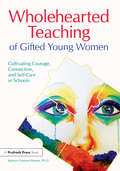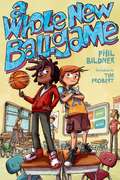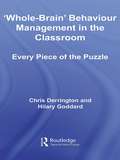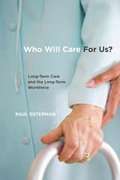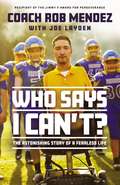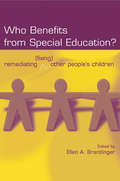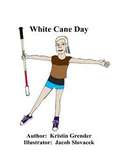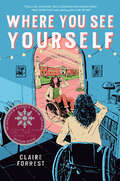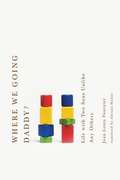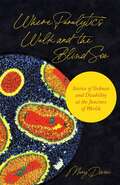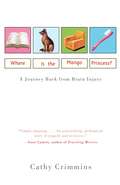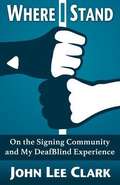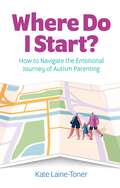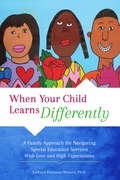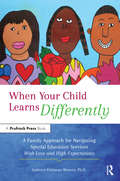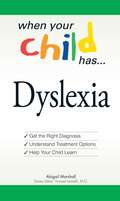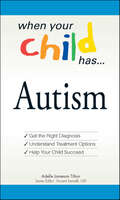- Table View
- List View
Wholehearted Teaching of Gifted Young Women: Cultivating Courage, Connection, and Self-Care in Schools
by Kathryn Fishman-WeaverWholehearted Teaching of Gifted Young Women explores the important role school communities play in supporting the social and emotional needs of high-achieving young women. Using a youth participatory action research model, this project follows 20 student researchers from high school through college. This longitudinal study leads to “Wholehearted Teaching,” a new framework for cultivating courage, connection, and self-care in schools. Framed with personal stories and filled with practical suggestions, this book offers strategies for teachers, counselors, parents, and high-achieving young women as they navigate the precipice of youth and everything after.
'Whole-Brain' Behaviour Management in the Classroom: Every Piece of the Puzzle
by Chris Derrington Hilary GoddardRepresenting a brave and insightful shift away from narrow perspectives on behaviour management, this book draws practitioners towards a more holistic understanding of ourselves and how we impact on children’s learning and behaviour. The authors’ brilliant new conceptual model of ‘whole-brain’ behaviour management challenges existing theories about the management of children’s behavioural issues. Their pioneering ‘whole-brain’ approach draws upon a range of influences and concepts that cross discipline boundaries, expanding on the practitioner’s understanding of the complexity of children’s behaviour through their own knowledge of neuroscience, biopsychosocial theory and interpersonal awareness. The book will take the reader through a process of self-evaluation in which their preferred ways of thinking, acting and relating will be explored and interpreted in order to help them understand the impact of their ‘personal style’ on how the children in their care behave. Offering new insights and creative solutions, this is a practical guide to coach practitioners in their personal and professional development, helping them to raise the achievement of children exhibiting even the most challenging of behaviour.
Who Will Care For Us? Long-Term Care and the Long-Term Workforce: Long-Term Care and the Long-Term Workforce
by Paul OstermanThe number of elderly and disabled adults who require assistance with day-to-day activities is expected to double over the next twenty-five years. As a result, direct care workers such as home care aides and certified nursing assistants (CNAs) will become essential to many more families. Yet these workers tend to be low-paid, poorly trained, and receive little respect. Is such a workforce capable of addressing the needs of our aging population? In Who Will Care for Us? economist Paul Osterman assesses the challenges facing the long-term care industry. He presents an innovative policy agenda that reconceives direct care workers’ work roles and would improve both the quality of their jobs and the quality of elder care. Using national surveys, administrative data, and nearly 120 original interviews with workers, employers, advocates, and policymakers, Osterman finds that direct care workers are marginalized and often invisible in the health care system. While doctors and families alike agree that good home care aides and CNAs are crucial to the well-being of their patients, the workers report poverty-level wages, erratic schedules, exclusion from care teams, and frequent incidences of physical injury on the job. Direct care workers are also highly constrained by policies that specify what they are allowed to do on the job, and in some states are even prevented from simple tasks such as administering eye drops. Osterman concludes that broadening the scope of care workers’ duties will simultaneously boost the quality of care for patients and lead to better jobs and higher wages. He proposes integrating home care aides and CNAs into larger medical teams and training them as “health coaches” who educate patients on concerns such as managing chronic conditions and transitioning out of hospitals. Osterman shows that restructuring direct care workers’ jobs, and providing the appropriate training, could lower health spending in the long term by reducing unnecessary emergency room and hospital visits, limiting the use of nursing homes, and lowering the rate of turnover among care workers. As the Baby Boom generation ages, Who Will Care for Us? demonstrates the importance of restructuring the long-term care industry and establishing a new relationship between direct care workers, patients, and the medical system.
Who-Who-Who Goes Hoo-Hoo-Hoo
by Peter SchneiderThis beautifully illustrated storybook has been written for children who stutter and their parents, carers and teachers. It tells the story of a young hedgehog who stutters and his encounters with several woodland creatures, some of whom stutter and others who do not. In the end they all work together to defeat a monster who lurks in the wood. The story makes clear that it is more important to listen to what someone says rather than the way they say it. It offers a positive message to children who stutter and shows other people, both adults and children, how best to react when talking to a child who stutters and the kind of responses to avoid. The book includes information about stuttering for adults and list of relevant organisations.
Who Says I Can't: The Astonishing Story of a Fearless Life
by Rob MendezOn paper, Coach Rob Mendez sounds like any other football coach on any other field across America: passionate, authoritative, knowledgeable. But he&’s unlike any other coach you know--in fact, he&’s probably unlike any other person you know.Born with an extraordinarily rare condition called tetra-Amelia syndrome, Rob has no arms or legs. He moves with the assistance of a custom-made, motorized wheelchair that he operates with his back and shoulders.Many people look at Rob and see limitation, yet Rob sees opportunity: Opportunity to pursue his passion for football. Opportunity to change the way people perceive physical disability. Opportunity to serve as a role model for the hundreds of kids he&’s coached over the years.Told with both humor and frankness, Who Says I Can&’t? takes readers on Rob&’s incredible journey, from his birth to loving parents who wanted to afford him every chance for happiness, to the emotional and physical hurdles he faced while seeking independence, to receiving the Jimmy V Award for Perseverance at the ESPY Awards in 2019.Each day, Coach Rob rolls onto the field and shows his players that dreams are achievable when you show up, do the work, and believe in yourself. And after reading this book you, too, will believe that anything is possible.
Who Bit My Tail?: Targeting the t Sound (Speech Bubbles 1)
by Melissa PalmerTiger wakes from a dream to find a big bite on his tail – but can he discover who is the culprit? This picture book targets the /t/ sound, and is part of Speech Bubbles 1, a series of picture books that target specific speech sounds within the story. The series can be used for children receiving speech therapy, for children who have a speech sound delay/disorder, or simply as an activity for children’s speech sound development and/or phonological awareness. They are ideal for use by parents, teachers or caregivers. Bright pictures and a fun story create an engaging activity perfect for sound awareness. Please see other titles in the series for stories targeting other speech sounds.
Who Benefits From Special Education?: Remediating (Fixing) Other People's Children (Studies in Curriculum Theory Series)
by Ellen A. BrantlingerWho Benefits From Special Education?: Remediating (Fixing) Other People's Children addresses the negative consequences of labeling and separating education for students with "disabilities," the cultural biases inherent in the way that we view children's learning difficulties, the social construction of disability, the commercialization of special education, and related issues.The theme that unifies the chapters is that tension exists between professional ideology and practice, and the wishes and expectations of the recipients of professional practice--children, adolescents, and adults with disabilities and their families. These voices have rarely taken center stage in formulating important decisions about the quality and characteristics of appropriate practice. The dominant view in the field of special education has been that disability is a problem in certain children, rather than an artifact that results from the general structure of schooling; it does not take into consideration the voices of people with disabilities, their families, or their teachers. Offering an alternative perspective, this book deconstructs mainstream special education ideologies and highlights the personal perspectives of students, families, and front-line professionals such as teachers and mental health personnel. It is particularly relevant for special education/disabilities studies graduate students and faculty and for readers in general education, curriculum studies, instruction theory, and critical theory.
White Harnesses
by R. G. CarterFrom the book Jacket:: White Harnesses is the story of the dogs that are trained to act as guides for blind people, to enable them to take up work and other interests, and thereby to enlarge their lives. The owner of a Guide Dog also enjoys a remarkable companionship based on mutual dependence and trust. The story of how this movement began, of the discovery of the best breeds, of the testing and choice of puppies, is an absorbing one. The author who is an experienced breeder of dogs, tells how Guide Dogs are fully trained, how each one is matched to a blind owner, and how this team lives and is trained together in a residential centre. The book ends with stories of some of the achievements of the dogs. The photographs, which are in colour and monochrome, include some specially taken of dogs in training at the centres of the Guide Dogs for the Blind Association, whose Chairman, The Earl of Lanesborough, has written a foreword.
White Coat, White Cane: The Extraordinary Odyssey of a Blind Physician
by David Hartman Bernard Asbell<P>The woman's arthritic fingers feel gnarled and crooked, her knees lumpy rocks. But I can detect no swelling, so I press here, there, trying to rouse an inflamed spot. "What are you doing"she challenges. "You're blind!" <P>"I'm examining you. Haven't you ever been examined by a blind doctor before?" <P>She refuses to be humored. "That's silly. What can a blind doctor do?" <P>"I'm not sure, but we're going to find out..." <P>When David Hartman, blind since the age of eight, announced his intention to become a doctor, the reactions ranged from sympathy to ridicule. How could he diagnose his patients? Examine them, except by touch? Look through a microscope? Even understand what was being described? <P>The battle lines were drawn: David and his family on one side, the schools and society on the other. But with an incredible strength of purpose, David Hartman went on to become the first blind person in over 100 years to enter medical school. What is it like to adjust to a world of darkness? David Hartman lets us know bluntly, with real emotion, insight, and humor. He had to relearn the simplest things. He had to overcome mental obstacles that were at times more formidable than the physical ones. Yet he was determined to reach beyond his difficulties to fulfill an impossible dream. <P>His teachers were helpful, hostile, embarrassed, unsure-and in medical school he had to work twice as hard. The work had to be read to him or translated into Braille. Often he had to rely on a sighted person to confirm his diagnosis, and he needed a nurse to read the patients' charts to him. But he utilized all his other senses to achieve his greatest desire: helping to heal. His journey is a moving and inspirational story for us all.
The Whistling Hangman (Duncan Maclain Mystery #2)
by Baynard KendrickWhen a wealthy man falls from the balcony of a luxury apartment hotel, blind detective Captain Duncan Maclain and his Seeing Eye dog Schnucke are on the case. Was it suicide or was it murder? This is the second book in the series that inspired the popular television show "Longstreet."
Where's Mummy Mouse?: Targeting the m Sound (Speech Bubbles 1)
by Melissa PalmerMolly mouse wakes to find her Mummy has vanished, so she sets off to find her – meeting some interesting creatures along the way. This picture book targets the /m/ sound, and is part of Speech Bubbles 1, a series of picture books that target specific speech sounds within the story. The series can be used for children receiving speech therapy, for children who have a speech sound delay/disorder, or simply as an activity for children’s speech sound development and/or phonological awareness. They are ideal for use by parents, teachers or caregivers. Bright pictures and a fun story create an engaging activity perfect for sound awareness. Please see other titles in the series for stories targeting other speech sounds.
Where You See Yourself
by Claire Forrest"Where You See Yourself is an absolutely necessary and affirming addition to YA shelves." -BuzzFeed BooksWhere You See Yourself combines an unforgettable coming-of-age tale, a swoon-worthy romance, and much-needed disability representation in this story about a girl who's determined to follow her dreams.By the time Effie Galanos starts her senior year, it feels like she’s already been thinking about college applications for an eternity—after all, finding a college that will be the perfect fit and be accessible enough for Effie to navigate in her wheelchair presents a ton of considerations that her friends don’t have to worry about.What Effie hasn’t told anyone is that she already knows exactly what school she has her heart set on: a college in NYC with a major in Mass Media & Society that will set her up perfectly for her dream job in digital media. She’s never been to New York, but paging through the brochure, she can picture the person she’ll be there, far from the Minneapolis neighborhood where she's lived her entire life. When she finds out that Wilder (her longtime crush) is applying there too, it seems like one more sign from the universe that it’s the right place for her.But it turns out that the universe is full of surprises. As Effie navigates her way through a year of admissions visits, senior class traditions, internal and external ableism, and a lot of firsts--and lasts--she starts to learn that sometimes growing up means being open to a world of possibilities you never even dreamed of. And maybe being more than just friends with Wilder is one of those dreams...
Where We Going, Daddy?: Life with Two Sons Unlike Any Others
by Jean-Louis FournierJean-Louis Fournier did not expect to have a disabled child. He certainly did not expect to have two. But that is precisely what happened to this wry French humorist, and his attempts to live and cope with his Mathieu and Thomas, both facing extremely debilitating physical and mental challenges, is the subject of this brave and heartbreaking book. Fournier recalls the life he imagined having with his sons-but his boys will never really grow up, and he mourns the loss of every memory he thought he’d have. Though a devoted father, he does not shy away from exploring the limits of his love, the countless times he is filled with frustration and disappointment with no relief in sight. Mathieu and Thomas can barely communicate, and each in turn repeats learned phrases, such as “Where we going, Daddy?” (a favorite in the car) in what feels to Fournier to be an eternal loop. InWhereWe Going, Daddy?Fournier reveals everything, and that is perhaps his most remarkable quality. He does not hide behind a mask of clicheacute;, but gives voice to the darkness that comes with disability, and the rare moments of light. Through short, powerful vignettes Jean-Louis manages his grief with cynicism and humor. For parents of disabled children, this book will offer some relief from the courage they must garner every day, a chance to let down their guard, laugh at themselves, and embrace even the ugly emotions they feel. For the rest of us, it’s an unsettling and heartfelt glimpse into an otherwise unimaginable life.
Where We Going, Daddy?
by Adriana Hunter Jean-Louis FournierJean-Louis Fournier did not expect to have a disabled child. He certainly did not expect to have two. But that is precisely what happened to this wry French humorist, and his attempts to live and cope with his Mathieu and Thomas, both facing extremely debilitating physical and mental challenges, is the subject of this brave and heartbreaking book. Fournier recalls the life he imagined having with his sons--but his boys will never really grow up, and he mourns the loss of every memory he thought he'd have. Though a devoted father, he does not shy away from exploring the limits of his love, the countless times he is filled with frustration and disappointment with no relief in sight. Mathieu and Thomas can barely communicate, and each in turn repeats learned phrases, such as "Where we going, Daddy?" (a favorite in the car) in what feels toFournier to be an eternal loop. In WhereWe Going, Daddy? Fournier reveals everything, and that is perhaps his most remarkable quality. He does not hide behind a mask of cliché, but gives voice to the darkness that comes with disability, and the rare moments of light. Through short, powerful vignettes Jean-Louis manages his grief with cynicism and humor. For parents of disabled children, this book will offer some relief from the courage they must garner every day, a chance to let down their guard, laugh at themselves, and embrace even the ugly emotions they feel. For the rest of us, it's an unsettling and heartfelt glimpse into an otherwise unimaginable life.
Where Paralytics Walk and the Blind See: Stories of Sickness and Disability at the Juncture of Worlds
by Mary DunnAn exploration of early modern accounts of sickness and disability—and what they tell us about our own approach to bodily differenceIn our age of biomedicine, society often treats sickness and disability as problems in need of solution. Phenomena of embodied difference, however, have not always been seen in terms of lack and loss. Where Paralytics Walk and the Blind See explores the case of early modern Catholic Canada under French rule and shows it to be a period rich with alternative understandings of infirmity, disease, and death. Counternarratives to our contemporary assumptions, these early modern stories invite us to creatively imagine ways of living meaningfully with embodied difference today.At the heart of Dunn’s account are a range of historical sources: Jesuit stories of illness in New France, an account of Canada’s first hospital, the hagiographic vita of Catherine de Saint-Augustin, and tales of miraculous healings wrought by a dead Franciscan friar. In an early modern world that subscribed to a Christian view of salvation, both sickness and disability held significance for more than the body, opening opportunities for virtue, charity, and even redemption. Dunn demonstrates that when these reflections collide with modern thinking, the effect is a certain kind of freedom to reimagine what sickness and disability might mean to us.Reminding us that the meanings we make of embodied difference are historically conditioned, Where Paralytics Walk and the Blind See makes a forceful case for the role of history in broadening our imagination.
Where Is the Mango Princess? A Journey Back from Brain Injury: A Journey Back From Brain Injury
by Cathy CrimminsHumorist Cathy Crimmins has written a deeply personal, wrenching, and often hilarious account of the effects of traumatic brain injury, not only on the victim, in this case her husband, but on the family.When her husband Alan is injured in a speedboat accident, Cathy Crimmins reluctantly assumes the role of caregiver and learns to cope with the person he has become. No longer the man who loved obscure Japanese cinema and wry humor, Crimmins' husband has emerged from the accident a childlike and unpredictable replica of his former self with a short attention span and a penchant for inane cartoons. Where Is the Mango Princess? is a breathtaking account that explores the very nature of personality--and the complexities of the heart.
Where I Stand: On The Signing Community And My Deafblind Experience
by John Lee ClarkThis collection of essays from one of the country's leading voices on issues facing the signing community appears at a time of troubling trends and exciting new developments. Through his lucid and accessible prose, John Lee Clark delves into questions ranging from why hearing parents of Deaf children don't sign to how written American Sign Language will change the course of Deaf literature. As a second-generation DeafBlind man, Clark also takes us on a tour of his experiences as a student, father, husband, and "client" of special services. Filled with startling observations and unapologetic assertions, Where I Stand challenges and broadens readers' understanding of an important but often overlooked community.
Where Do I Start?: How to navigate the emotional journey of autism parenting
by Kate Laine-TonerRecognising that your child is autistic is a pivotal moment for parents and carers. While it can lead to positives in terms of understanding behaviour and accessing support, the diagnostic process itself can be a huge source of anxiety, stress, guilt and worry.But it's going to be ok - because right here you have the ultimate guidebook to navigating the emotions and challenges that these early stages present.From weathering the initial impact of a potential diagnosis, to self-care strategies and finding new parameters for success, reading this book is like being taken by the hand and shown how to look after your own mental health while supporting your child. Each chapter is full of guidance from someone who's been where you are now, and tells you what you really need to know so you can journey from panic and uncertainty to confidence, acceptance and strength.
When Your Child Learns Differently: A Family Approach for Navigating Special Education Services With Love and High Expectations
by Kathryn Fishman-WeaverAdvocating for a child who learns differently can sometimes feel like an isolating and daunting task. This book reminds families that they are not alone. When Your Child Learns Differently is a compassionate guide that:Helps families navigate special education services from the inside out.Offers targeted advice to families of children with a wide range of disabilities and challenges.Shares valuable information about special education language, policy, procedures, and supports.Reminds families that they are the most important advocates in their child's success plan.Draws on the author's experiences as both a parent and special education teacher.Accessible and encouraging, this guide humanizes the journey of caring for children who learn differently. Readers will leave the book empowered with practical policy knowledge and energized by the belief that, with love and high expectations, almost anything is possible.
When Your Child Learns Differently: A Family Approach for Navigating Special Education Services With Love and High Expectations
by Kathryn Fishman-WeaverAdvocating for a child who learns differently can sometimes feel like an isolating and daunting task. This book reminds families that they are not alone. When Your Child Learns Differently is a compassionate guide that:
When Your Child Has . . . Dyslexia
by Vincent Iannelli Abigail MarshallFinding out that a child has dyslexia can be shocking and confusing - and thousands of parents get this disturbing news every day. Appearing as early as when a child is struggling to say "Mama" and "Dada," dyslexia is a condition that will affect a child's ability to read, write, and understand basic language construction - and for a parent, this can be a tough reality to take in. Covering information on every stage of diagnosis, treatment, and growth, this reference will help parents: teach children how to cope with educational, personal, and social difficulties; choose the right school and reduce academic struggles; maintain communication with their frustrated child; and more. Providing parents with the invaluable information and resources they need, this book takes an in-depth look at the reality of the disability and manages to make sense of it for worried parents.
When Your Child Has . . . Dyslexia: Get the Right Diagnosis, Understand Treatment Options, and Help Your Child Learn (When Your Child Has Ser. )
by Abigail Marshall Vincent IannelliFinding out that a child has dyslexia can be shocking and confusing - and thousands of parents get this disturbing news every day. Appearing as early as when a child is struggling to say “Mama” and “Dada,” dyslexia is a condition that will affect a child’s ability to read, write, and understand basic language construction - and for a parent, this can be a tough reality to take in. Covering information on every stage of diagnosis, treatment, and growth, this reference will help parents: teach children how to cope with educational, personal, and social difficulties; choose the right school and reduce academic struggles; maintain communication with their frustrated child; and more. Providing parents with the invaluable information and resources they need, this book takes an in-depth look at the reality of the disability and manages to make sense of it for worried parents.
When Your Child Has . . . Autism (When Your Child Has A . . .)
by Adele Jameson TiltonHearing the words ôyour child has Autismö is more common than ever. But dealing with this news will never be easy. When the devastating diagnosis is made, millions of questions and concerns will flood parentsÆ brains. This book will answer panicked parentsÆ questions in clear and complete terms. Taking an in-depth look at the reality of the disability, its causes, and how to cope as a family, this professional yet personal primer will help parents get through those first oh-so-tough times after the diagnosis. Autism is a complex developmental disabilityùthere are no medical tests for diagnosing autism and there is no ôcure.ö Parents need an accessible resource to go to for help in a hurryùwhen they donÆt know where else to turn and what is going to happen next.
